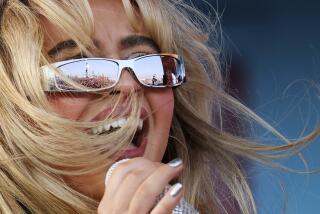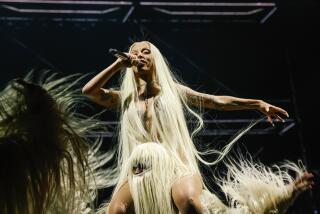Coachella 2012: Dr. Dre, Snoop Dogg star; others could steal thunder
The venerable Southland legends Snoop Dogg and Dr. Dre headline Sunday’s set at the Coachella Valley Music & Arts Festival. Hard-core hip-hop heads are salivating at the prospect that Dre might preview his overdue opus “Detox,” and the pleasures of a sold-out field bumping to Snoop’s “Gin and Juice” are self-evident.
But MCs on Coachella’s hip-hop undercard, including Compton’s Kendrick Lamar and Harlem’s ASAP Rocky, also have the potential to emerge from the fest as major new stars. With peers including Azealia Banks, producer araabMUSIK and gloomy crooners the Weeknd and Frank Ocean also on the bill at the festival in Indio, Calif., this is the best year for hip-hop and R&B in Coachella history. That’s an ironic twist considering that the festival came to hip-hop late in the game — 2010 was the first year Coachella featured a headliner from the rap world (Jay-Z) since its 1999 founding.
This year’s must-see sets from Lamar and Rocky could cement Coachella as a prime venue for ambitious MCs to pivot into stardom.
COACHELLA 2012 | Full coverage
Lamar, a 24-year-old Dr. Dre protege, has been touted as a bright hope for a resurgent L.A. rap scene. After years of the South dominating the national hip-hop conversation, SoCal reclaimed the genre’s lead last year with the rise of the anarchic rapper-producer-design collective Odd Future (which played an enthusiastically messy 2011 Coachella set).
While Lamar owes a clear debt to the sound pioneered by the likes of Tupac Shakur, Dre and Snoop, he’s more concerned with documenting the Compton of today.
“I want to show Compton in a different light,” Lamar said. “People think it’s just gangsta rap, but we’ve been creating the new sound of Compton.”
Lamar earned buzz after his 2010 mixtape “(O)verly (D)edicated,” and his career vaulted to a new level with last year’s digital-only album “Section.80.” Over crisp drums and immersive, hazy productions, Lamar showcased a novelist’s sensitivity to the emotional nuances of Compton life.
“Keisha’s Song (Her Pain)” and “Tammy’s Song (Her Evils)” were empathetic character portraits of strong yet embattled women, and “A.D.H.D.” described millennial prescription-pill culture in ways only a millennial MC could articulate.
Alongside his rising Black Hippy crew, Lamar updates the Compton legacy to today’s digitized world.
Compton’s old guard has noticed him too. Dr. Dre has taken Lamar as a pupil, signing him to his storied Aftermath imprint of Interscope (which made stars of Eminem, 50 Cent and the Game), reportedly giving him major cameos on tracks from the forthcoming “Detox” and overseeing Lamar’s forthcoming debut, “Good Kid in a Mad City.”
Lamar won’t divulge whether he’ll be joining Dre and Snoop onstage during their headlining set, which the two will repeat April 22 as part of Coachella’s expansion this year to a two-weekend festival. But he did acknowledge the not-coincidental importance of their Coachella pairing this year, and how it will re-introduce a diverse crowd to one of L.A.’s defining sounds.
“When I talked about certain streets in Compton in lyrics, he knew them,” Lamar said. “He’s still in tune with the sound of what’s in the streets. But now that I have my core, the challenge is to reach a broader audience. They’re gonna hear cats coming out of Compton with a different sound, and I want the world to understand.”
Across the country, a second crew of young MCs has been revamping New York’s hip-hop culture. A$AP Mob is a sprawling posse of Harlem-based rappers and producers, led by 23-year-old Rakim Mayers, who performs as ASAP Rocky. Rocky has just one free mixtape to his name, 2011’s “LiveLoveA$AP,” but it was instantly regarded as one of the year’s strongest rap releases.
Buoyed by the atmospheric and often sad-eyed beats from A$AP member Clams Casino, Rocky’s minimalist yet venomous flow made for incredibly dark party music. Spooky singles including “Peso” and “Purple Swag” felt tailor-made for an era of laptop nihilism.
“Before, it was all girls, weed and partying,” Rocky said, with a deep yawn during a midafternoon interview, suggesting recent familiarity with those topics. “Now, I’m going to talk more about troubles and anxieties, but just enough. You don’t want to bore people.”
For his forthcoming commercial debut, Rocky signed a multimillion-dollar deal with RCA. In a time of tightened budgets, the deal made news, especially given Rocky’s relative newcomer status. He admits that he’s “only really been in the game for four or five months” and that a recent arena tour opening (along with Lamar) for Drake was thrilling but that playing to unfamiliar audiences underlined the hard work needed to cement stardom.
But true to his namesake — the legendary New York City rapper Rakim — Rocky is clear in his goals to define a generation of that city’s rap. And part of that is to leave much of the genre’s cultural baggage behind. Rocky — who is straight — has been outspoken in his criticism of homophobia in hip-hop, and his braggadocio has an Oscar Wilde-ish touch (he calls himself “pretty” in lyrics).
It’s not just savvy audience outreach. Rocky’s gay positivity also may be the clearest example of how this year’s Coachella rap acts want to leave the genre’s old squabbles behind and show broad crowds something new. All while rocking parties like their veteran peers.
“Fashion is a big part of this generation, especially inner-city youth. And almost all those designers are homosexual — I’m good friends with Jeremy Scott and Alexander Wang, along with lots of not-famous gay men. If you discriminate, you’re an idiot,” Rocky said. “I respect openly gay men. Rappers used to be so orthodox and belligerent and all big-neck-veins in the ‘90s. I grew up in a homophobic world, but when I came of age I decided that wasn’t how I wanted to treat people. As a black man, I don’t want to put that energy out into the world.”
COACHELLA 2012 | Full coverage
More to Read
The biggest entertainment stories
Get our big stories about Hollywood, film, television, music, arts, culture and more right in your inbox as soon as they publish.
You may occasionally receive promotional content from the Los Angeles Times.







